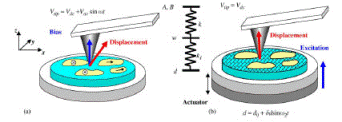Department of Physics and Astronomy: Publications and Other Research

Alexei Gruverman Publications
Document Type
Article
Date of this Version
October 2003
Abstract
The structural and electrical properties of Pb(Zr0.35Ti0.65)O3 (PZT) thin films ranging in thickness from 700 to 4000 Å have been investigated. These (001)/(100)-textured films were grown by metalorganic chemical vapor deposition on (111)-textured Ir bottom electrodes. It was observed that, in the as-deposited state, the thinnest PZT films are rhombohedral even though bulk PZT of this composition should be tetragonal. Thicker films have a layered structure with tetragonal PZT at the surface and rhombohedral PZT at the bottom electrode interface. In this article we investigate the origin of this structure and its effect of the ferroelectric and dielectric properties of PZT capacitors. It has been suggested that thin films stresses can affect the phase stability regions of single domain PZT. This possibility has been investigated by piezoresponse microscopy and thin film stress measurements. In the as-deposited state the majority of PZT grains contain a single ferroelastic domain, whereas after a high temperature anneal, a large fraction of the grains contain several ferroelastic domains. Wafer curvature measurements in combination with x-ray diffraction stress measurements in the Ir bottom electrode showed that the as-deposited PZT films are, within experimental error, stress free at room temperature. Landau–Ginbzurg–Devonshire formalism was used to explain the origin of the rhombohedral phase as a result of substrate constraint on single domain PZT grains. Annealing was found to affect the relative volume fractions of the rhombohedral and tetragonal phases and the electrical properties of PZT films. Intermediate temperature anneals increased the volume fraction of the rhombohedral phase and the coercive field extracted from the polarization-electric field hysteresis loops. After a high temperature anneal (650 °C) the majority of the grains transformed into a polydomain state, decreasing the volume fraction of the rhombohedral phase and the coercive field. If the high temperature anneal was performed after deposition of the top electrode, the coercive field became independent of the PZT thickness.


Comments
Published in J. Appl. Phys., Vol. 94, No. 8, 15 October 2003. Copyright © 2003 American Institute of Physics. Used by permission.